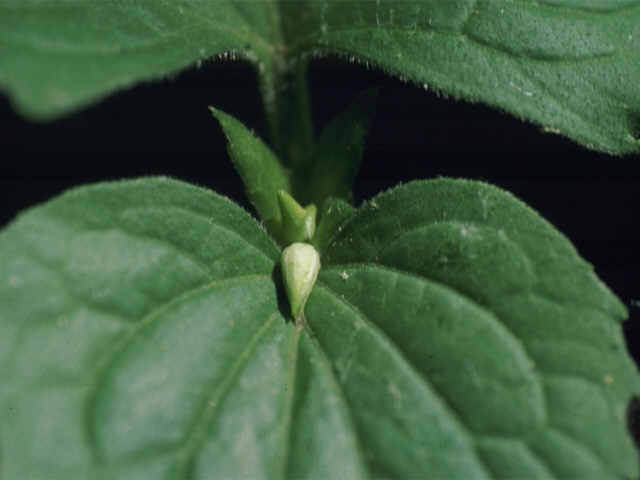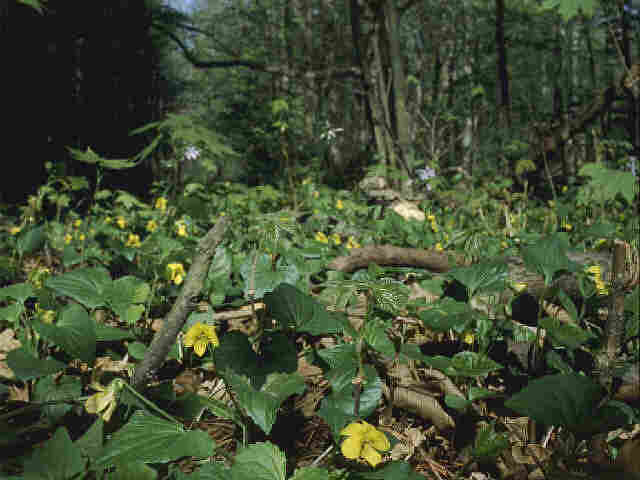As
anyone knows who has violets growing in their garden or front lawn, they
have an amazing ability to persist and even to spread across an area
over time. A small violet in a garden may live for a year or two before
many others appear in neighboring flowerbeds. Over time, violets may
thread themselves through the lawn, like scouts before an impending
army. Other species prefer to sit patiently in the soil, awaiting the
occasional arrival of a fellow member. How do these violets survive so
long and why are they so successful?
Many violet species thrive because they are able to do a number of
different things. First, many species can produce seeds through two
different types of flowers. Showy chasmogamous (CH) flowers (Fig. 1), so
familiar to violet fanciers, are often visited by insects, which
promotes cross-pollination between different plants. In contrast, closed
cleistogamous (CL) flowers resemble small buds that never open (Fig. 2)
and are produced near the top or at the base of the plant. The
self-pollinated CL flowers are often viewed as the "back-up
plan" in case pollinators are scarce any one year, ensuring that
the plant can still make seeds. These two flower types also allow some
violet species in deciduous forests to produce seeds in two totally
different environments. For example, in the downy yellow violet, Viola
pubescens, CH flowers appear in the early spring in the bare forests as
other spring ephemerals begin to flower. During this time, light can
easily reach the forest floor, and insects are likely to find and visit
the showy flowers. However, plants stop making the CH flowers once
leaves start forming on the trees above. As the amount of light on the
forest floor drops to about 7% of what it once was and other spring
ephemerals die back (e.g., Trillium, spring beauty), V. pubescens begins
to make the self-pollinated CL flowers. An individual plant usually
produces similar numbers of CH and CL flowers (about 3-5). Both types of flowers also have
similar numbers of seeds per fruit (8-11). Thus, many violets can still
continue to produce seeds under conditions that are unfavorable to other
plants.
| |

|
(Figure 2.) Cleistogamous (CL) Flower Of The
Downy Yellow Violet, Viola pubescens
|
|
|
Violets are also successful because of the way they disperse their
seeds. Both CH and CL seeds in many species are ballistically scattered
over long distances. This happens as the three valves (sides) of each
fruit dry and slowly squeeze shut, effectively shooting out the seeds
over a period of an hour or more (similar to pinching marbles between
two fingers). For example, the downy yellow violet, Viola pubescens,
and the Canadian violet, V. canadensis, scatter their seeds up to
five meters away. In some stemless species (e.g., Viola sororia),
the CL fruits can even turn down into the soil and slowly spiral along
underground for a foot or so, before emerging to release their seeds.
Many violet species also have a second way of dispersing their seeds.
These violets produce a pale-colored, protein-rich structure (called an
elaisome) attached to their seeds. This structure is a favorite food of
ants, which will find the seeds on the ground and carry them back to
their nest. There they gnaw off the elaisome and dump the seeds into
their nutrient-rich underground trash heap, which is a great place for
seeds to grow (if not too deep underground). Such ant-dispersal often
results in seeds traveling another meter or so away from the mother
plant (Culver and Beattie, 1978). Because of these two ways of
dispersing their seeds, some violets can easily spread over an area
within a few years.
Another reason why violets do so well is that most species are perennial
and several also reproduce vegetatively, thus persisting for long
periods of time. These types of violets often send stolons or runners
aboveground (e.g., V. lanceolata, V. blanda) to form new
plantlets. Often in a patch of violets, what looks like many plants
clustered together is only one individual. That is, the plantlets can
usually be traced back to a common origin. In this case, each plantlet
is known as a ramet and the entire group of ramets is called a genet
(i.e., a genetic individual) or a clone. Together with its perennial
habit, this type of clonal growth ensures that the individual plant can
survive and grow larger from year to year.
Violets also have an advantage over other plant species because they
have an underground storage structure, the rhizome. This is actually a
horizontal stem, often with scalelike leaves and buds, that allows
plants to survive harsh conditions by storing up nutrients. Rhizomes are
very important in cold climates, dry areas, and in lawns that are
frequently mowed. The rhizome is also a means of vegetative propagation
because it may sometime branch, forming a new ramet that usually remains
attached to the mother plant (e.g., V. sororia; Solbrig, 1981).
| |

|
(Figure 3.) Downy Yellow Violet, Viola pubescens
In Full Spring Bloom
|
|
|
So it appears that the main reason why violets are so successful is that
they have become well-adapted to persisting in and invading new areas.
Several violet species are better at this than others because they
possess several of the above characteristics. These plants are likely to
produce both flower types, have seeds that disperse far, reproduce
vegetatively (in addition to the sexual reproduction), and have a large
rhizome. On the other hand, other violet species that have only a few of
these qualities may be more likely to be solitary and spread very
slowly. However violets persist and spread, they continue to delight the
viewer with their vibrant array of color each spring. For the true
violet fancier, the sight of a group of violets flowering is a sight to
behold for many days to come (Fig. 3).